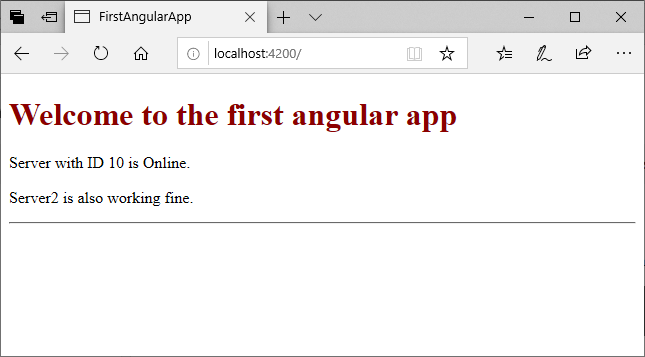📌 相关文章
- Angular 8中的字符串插值(1)
- Angular 8中的字符串插值
- C# 中的字符串插值(1)
- c++中的字符串插值(1)
- Python字符串插值(1)
- Python字符串插值
- Python字符串插值
- C# 代码示例中的字符串插值
- c++代码示例中的字符串插值
- JavaScript 中的字符串插值(1)
- JavaScript 中的字符串插值
- javascript中的字符串插值(1)
- 字符串插值 - Javascript (1)
- 字符串插值 javascript (1)
- 字符串插值 - Javascript 代码示例
- javascript代码示例中的字符串插值
- 字符串插值 javascript 代码示例
- js 字符串插值 - Javascript (1)
- Scala字符串插值
- Scala字符串插值(1)
- python 字符串插值 - Python (1)
- js 字符串插值 - Javascript 代码示例
- pandas 插值字符串 - Python (1)
- 红宝石 |字符串插值(1)
- 红宝石 |字符串插值
- python 字符串插值 - Python 代码示例
- pandas 插值字符串 - Python 代码示例
- 插值和外插的区别
- 插值和外插的区别(1)
📜 Angular 7字符串插值
📅 最后修改于: 2020-12-16 05:10:11 🧑 作者: Mango
Angular 7字符串插值
在Angular中,字符串插值用于在HTML模板上显示动态数据(在用户端)。它使您可以对component.ts文件进行更改,并从那里获取数据到HTML模板(component.html文件)。
例如:
component.ts文件:
import {Component} from '@angular/core';
@Component(
{selector: 'app-server',
templateUrl: 'server.component.html'})
export class ServerComponent {
serverID: number = 10;
serverStatus: string = 'Online';
}
在这里,我们使用一些值指定了serverID和serverStatus。让我们在“ component.html”文件中使用它。
component.html文件:
Server with ID {{serverID}} is {{serverStatus}}.
输出:

字符串插值与属性绑定
字符串插值和属性绑定都用于同一目的,即单向数据绑定。但是问题是如何知道哪一个最适合您的应用程序。
在这里,我们在相似性,差异,安全性和您收到的输出方面进行比较。
黑白字符串内插和属性绑定的相似性
字符串插值和属性绑定是关于单向数据绑定的。它们都将一个值从我们的组件传递到HTML元素。
字符串插值
import { Component } from '@angular/core';
@Component({
selector: 'my-app',
template: `
{{ fullName }}
`
})
export class AppComponent {
fullName: string = 'Robert Junior';
}
您可以在上面的示例中看到,Angular从组件中获取fullName属性的值,并使用花括号将其插入到开始和结束
元素之间,以用于指定插值。
属性绑定
import { Component } from '@angular/core';
@Component({
selector: 'my-app',
template: `
`
})
export class AppComponent {
fullName: string = 'Robert Junior';
}
在“属性绑定”中,查看Angular如何从组件的fullName属性中提取值,并使用
元素的html属性innerHtml将其插入。
字符串插值和属性绑定的两个示例将提供相同的结果。
字符串插值和属性绑定之间的区别
字符串插值是一种特殊的语法,可通过Angular转换为属性绑定。这是属性绑定的便捷替代方法。
当需要连接字符串,必须使用插值而不是属性绑定。
例:
@Component({
selector: 'my-app',
template: `
{{citedExample}}
`
})
export class AppComponent {
citedExample: string = 'Interpolation foe string only';
}
当您必须将元素属性设置为非字符串数据值时,将使用属性绑定。
例:
在下面的示例中,我们通过绑定到布尔属性isDisabled来禁用按钮。
import { Component } from '@angular/core';
@Component({
selector: 'my-app',
template: `
`
})
export class AppComponent {
isDisabled: boolean = true;
}
如果使用插值而不是属性绑定,则无论isDisabled类属性值是true还是false,该按钮将始终处于禁用状态。
import { Component } from '@angular/core';
@Component({
selector: 'my-app',
template: `
`
})
export class AppComponent {
isDisabled: boolean = true/false;
}